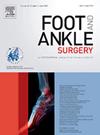莫顿神经瘤切除术中足底法与背侧法术后效果的比较:系统回顾与荟萃分析。
IF 1.9
3区 医学
Q2 ORTHOPEDICS
引用次数: 0
摘要
背景:目前的文献缺乏比较足底和足背法治疗 Civinini-Morton 综合征(又称莫顿神经瘤)临床疗效的全面信息。本系统综述和荟萃分析旨在评估和比较莫顿神经瘤神经切除术的临床疗效,重点关注足底和足背法的差异:我们的综合文献综述遵循了系统综述和荟萃分析首选报告项目(PRISMA)指南,并使用了包括 PubMed、Embase、Web of Science 和 Cochrane 图书馆在内的数据库。本研究调查的数据包括术后感觉缺失、瘢痕触痛、再次手术、组织病理学、并发症、疼痛评分、患者满意度、功能评分和负重时间:本研究共纳入八项研究。共有 237 例神经瘤采用足底入路进行切除,312 例神经瘤采用足背入路进行治疗。背侧组术后感觉减退的比例明显更高:48.5% (64/132) Vs. 62.0% (80/129),相对比率 (RR) 为 0.79 (95 % CI, 0.64-0.97)。足底组术后疤痕触痛率明显更高:16.7% (32/192) Vs. 6.2% (14/225),RR 为 2.27 (95 % CI, 1.28-4.04)。在组织病理学方面,跖侧入路和背侧入路的准确率分别为 99.3%(143/144)和 97.1%(134/138),RR 为 1.02(95% CI,0.98-1.07)。总的再手术率和并发症在各组之间没有差异,跖入路组分别为5.3%(10/189)和8.8%(19/216),而背入路组分别为6.1%和12.0%(35/291):我们建议在手术前与患者进行详细讨论,权衡每种方法的利弊。本文章由计算机程序翻译,如有差异,请以英文原文为准。
The comparison of postoperative outcomes in Morton's neuroma excision between plantar versus dorsal approach: A systematic review and meta-analysis
Background
Current literature lacks comprehensive information comparing the clinical outcomes of plantar and dorsal approaches for Civinini-Morton syndrome, also known as Morton's neuroma. This systematic review and meta-analysis was conducted to evaluate and compare the clinical outcomes of neurectomy for Morton's neuroma, focusing on the differences between the plantar and dorsal approach.
Methods
Our comprehensive literature review adhered to the Preferred Reporting Items for Systematic Reviews and Meta-Analyses (PRISMA) guidelines and utilized databases including PubMed, Embase, Web of Science, and the Cochrane Library. Data investigated in this study included postoperative sensory loss, scar tenderness, reoperation, histopathology, complications, pain score, patient satisfaction, functional scores, and time to weight bearing.
Results
Total eight studies were included in this study. In aggregate, 237 neuromas underwent excision using the plantar approach, while 312 neuromas were treated via the dorsal approach. A significantly higher rate of postoperative reduced sensory was found in the dorsal group: 48.5 % (64/132) Vs. 62.0 % (80/129) with the relative ratio (RR) of 0.79 (95 % CI, 0.64–0.97). A significantly higher rate of postoperative scar tenderness was noted in the plantar group: 16.7 % (32/192) Vs. 6.2 % (14/225) with the RR of 2.27 (95 % CI, 1.28–4.04). Regarding the histopathology, 99.3 % (143/144) and 97.1 % (134/138) accuracy rate was confirmed in the plantar approach and dorsal approach, respectively, with the RR of 1.02 (95 % CI, 0.98–1.07). Overall reoperations and complications were not different between groups at 5.3 % (10/189) and 8.8 % (19/216) in the plantar group versus 6.1 % and 12.0 % (35/291) in dorsal group.
Conclusions
We recommend detailed discussions with patients prior to surgery to weigh the advantages and disadvantages of each approach.
求助全文
通过发布文献求助,成功后即可免费获取论文全文。
去求助
来源期刊

Foot and Ankle Surgery
ORTHOPEDICS-
CiteScore
4.60
自引率
16.00%
发文量
202
期刊介绍:
Foot and Ankle Surgery is essential reading for everyone interested in the foot and ankle and its disorders. The approach is broad and includes all aspects of the subject from basic science to clinical management. Problems of both children and adults are included, as is trauma and chronic disease. Foot and Ankle Surgery is the official journal of European Foot and Ankle Society.
The aims of this journal are to promote the art and science of ankle and foot surgery, to publish peer-reviewed research articles, to provide regular reviews by acknowledged experts on common problems, and to provide a forum for discussion with letters to the Editors. Reviews of books are also published. Papers are invited for possible publication in Foot and Ankle Surgery on the understanding that the material has not been published elsewhere or accepted for publication in another journal and does not infringe prior copyright.
 求助内容:
求助内容: 应助结果提醒方式:
应助结果提醒方式:


